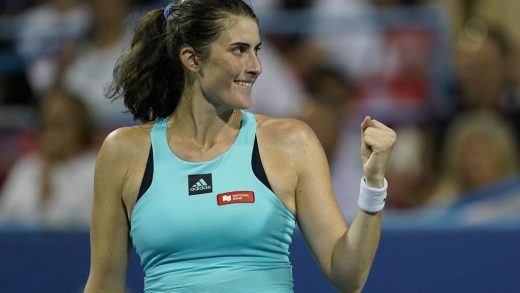
Te reo Māori Aotearoa could be the waka that takes young Cook Islanders closer to their mother tongue.
Ko te reo Māori Aotearoa pea te waka e ū ake ai a ngāi Kūki ‘Āirani ki tō rātou reo rangatira.
While very few Kūki ‘Āirani in Aotearoa can speak their language, some have learnt the reo Māori of the whenua they live on today, and built a foundation upon which to learn their own reo.
Ahakoa he tokoiti ngāi Kūki ‘Āirani e mōhio ana ki tō rātou reo rangatira, kua ākona e ētahi te reo Māori o te whenua e nōhia nei e rātou, kua whai tūāpapa e ākona ai tō rātou ake reo.
READ MORE:
* Culture Calendar: What’s on in Auckland this August
* Cook Islands Language Week: Fishy find sparks linguistic lesson at Auckland Museum
* Cook Islands Language Week opens with new digital hub for kōrero Kūki ‘Āirani
Inano Walter (nō Akatokamanava e Tumutevarovaro) grew up without her mother tongue, but learned te reo Māori Aotearoa to fluency. Learning her own language came a bit easier, she said.
I tupu ake a Inano Walter (nō Akatokamanava e Tumutevarovaro) me te korenga reo rangatira ōna, heoti kua matatau ia ki te reo Māori Aotearoa. Kua ngāwari ake tāna ako i tōna ake reo, hei tāna.
“If I hadn’t had the knowledge of te reo Māori to aid in the structure of the language, I would be memorising phrases instead of trying to construct conversations,” she said.
“Me i kore ai tōku mōhio ki te reo Māori kia tautokona te whakatakotoranga o te reo, kua mate au ki te tuhi i ngā kīanga ki te rae, kaua kē te waihanga i ngā whakawhitinga kōrero,” hei tāna.
“If I didn’t have it, it would have made my journey quite a lot harder, and less enjoyable. I probably would give up a lot easier, I’d probably get quite frustrated – mainly because of the lack of resources.”
”Mēnā kāore i ahau, kua pakeke kē atu tōku ara, kua ngahau iho. E tinga ana, kua mate wheke, korekore kua matekiri – he iti noa nō ngā rauemi.”
Dr Ake Nicholas (Ngā Pū Toru, Ma’uke) is a linguist and specialises in te reo Māori of Aotearoa and Kūki ‘Āirani.
He tohunga wetereo a Tākuta Ake Nicholas (Ngā Pū Toru, Ma’uke) i ngā reo Māori Aotearoa me Kūki ‘Āirani.
She said the two languages are still different, but as the closest relatives to each other, there is plenty to learn.
Hei tāna, inā tonu te rerekē o ngā reo, engari he whanaunga tata nō ngā reo nei, inā hoki te rahi o ngā akoranga.
“They are not so the same that they are fully mutually intelligible,” she explained.
”Kāore i pērā rawa te ōritetanga kua mārama kehokeho ki ngā reo e rua,” tāna whakamahuki.
“There is enough different that you still have to do some learning, but you won’t have to do all that basic vocab learning, which is the hard work as an adult language learner.”
“Tērā tonu ētahi rerenga kētanga kua mate koe ki te ako, engari kāore koe mō te ako i ērā puna kupu, ā, koia te mea uaua me he ākonga pakeke koe.”
Dr Emma Powell (Atiu, Mangaia) was never taught te reo Māori Kūki ‘Āirani as a child either, and learned te reo Māori Aotearoa when she began working at the Waitangi Tribunal. The intense immersion there meant she became fairly fluent within 18 months.
Kīhai i whakaakona te reo Māori Kūki ‘Āirani ki a Tākuta Emma Powell (Atiu, Mangaia) nōna e tamaiti ana, ka mutu, i ākona te reo Māori Aotearoa nōnā kē i tīmata ki te mahi ki te Taraipiunara Waitangi. He kaha nō te rumakitanga i korā i rere pai te reo i ngā marama 18.
Supplied
Dr Emma Powell is a lecturer at the University of Otago and learned te reo Māori Aotearoa to fluency before learning her own reo. / He pūkenga a Tākuta Emma Powell ki Te Whare Wānanga o Ōtākou, i ākona te reo Māori Aotearoa kia matatau ia i mua i te ako i tōna ake reo.
“It’s quite a unique context… where you can be exposed to the language every day,” she said.
”He horoparki ahurei….. e pāngia ai koe e te reo i ia rā,” tana kōrero.
While working for the tribunal, Powell went back to study for her PhD, looking intently at Cook Island literature written in te reo Kūki ‘Āirani. It was then she realised just how much she could absorb now that she was fluent in te reo Māori Aotearoa.
I a ia e mahi ana ki te taraipiunara, i hoki a Powell ki te ako i tāna tohu Kairangi, me te āmiki tiro ki ngā tuhinga Kūki ‘Āirani i te reo Kūki ‘Āirani. Kātahi ia ka kite i te rahinga e taea ana e ia te mitimiti, he kōrero Māori Aotearoa nōna.
“It made looking at Cook Island texts in the archive possible in a way that hadn’t been possible before. And I was only getting impressions – the languages are still separate languages, but I had the grammatical structures of New Zealand Māori.”
“I taea te pānui i ngā tuhinga Kūki ‘Āirani ki te pūranga, ā, kāore i pēnā i mua rā. I te kite noa au i ngā taporetanga – he reo motuhake tonu ngā reo, engari i ahau ngā wetereo o te reo Māori Aotearoa.”
Without the strength of te reo Māori Aotearoa education, Powell said gaining her own language would have been a struggle.
Me i kore te kaha o te mātauranga reo Māori Aotearoa, hei tā Powell, kua karawheta ia ki te ako i tōna ake reo.
“We are primary English thinkers… sometimes, understanding a tirohanga Māori perspective here in Aotearoa can get us that much closer to our own ancestral language in a way that English will never be able to do for us.”
“He whakaaro reo Pākehā mātou… heoti mā te mārama ki te tirohanga Māori ki Aotearoa nei e pātata ake ai mātou ki tō mātou ake reo tūpuna, e kore nei e oti i mātou mā te reo Pākehā.”
Supplied
Liam Koka’ua was raised with some te reo Kūki ‘Āirani at home, but had to attend classes to learn to speak fluently as an adult. / Tupu ake ai a Liam Koka’ua me te reo Kūki ‘Āirani ki te kāinga, engari i mate ki te toro ki ngā akoranga e matatau ai hei pakeke.
Liam Koka’ua (Ngāti Ārera, Rarotonga) and Brandon Mataio Jammae Ulfsby (Te Pū Tauhunu, Ngāti Pitiaua) and were both raised with te reo Kūki ‘Āirani around their homes, but rarely uttered it themselves. Growing up, they could understand most of what was spoken to them but couldn’t respond.
I tupu a Liam Koka’ua (Ngāti Ārera, Rarotonga) rāua ko Brandon Mataio Jammae Ulfsby (Te Pū Tauhunu, Ngāti Pitiaua) ki ngā kāinga i rere te reo Kūki ‘Āirani, engari me uaua tā rāua hamumu. Nō rāua e tupu ana, kua mārama ki te nuinga o ngā kōrero ki a rāua, engari anō tā rāua urupare atu.
Koka’ua said learning where the languages crossover and where they differ is a daily thrill.
Hei tā Koka’ua, he wana tō te ako i ngā ōritetanga me ngā rerenga kētanga o ngā reo i ia rā.
In Kūki ‘Āirani, the native pigeon that in Aotearoa is called kererū is called rupe – the same name Māui takes on when he transforms himself into a pigeon to kidnap his sister Hinauri when he misses her in the Aotearoa myth.
Ki ngā Kūki ‘Āirani, e kīia nei he rupe te manu taketake e noho nei ki Aotearoa, arā, te kererū – e ōrite ana ki te tapanga nō tā Māui huri hei rupe kia whānakohia tōna tuahine, a Hinauri, i tōna mokemoke ki a ia i te pūrākau ki Aotearoa.
Then there is the smaller fruit dove, that in Kūki ‘Āirani is called kūkupa. It shares a name with kererū, the name it’s given up north, Koka’ua said.
Tērā hoki te manu iti o ngā huarākau, kua taipaina ko te kūkupa ki ngā Kūki ‘Āirani. He ōrite tōna ingoa ki te kererū, me tōna ingoa i te nōta, hei tā Koka’ua.
“I discover new words every day in te reo Māori which I find out later were used in Rarotonga, and vice versa,” he said.
“Kitea ai ngā kupu hōu e au i ia rā i te reo Māori, nā wai kua kōrerohia kētia ki Rarotonga, me te tauaro hoki,” tāna kōrero.
Supplied
Brandon Ulfsby learned to understand te reo Kūki ‘Āirani but until recently could barely speak it.
Ulfsby started speaking te reo Kūki ‘Āirani in earnest when the threat of its extinction started to feel real. It made him into a language warrior, he said.
I nako a Ulfsby ki te tīmata ki te kōrero i te reo Kūki ‘Āirani mō te tūpono pai ka mate ā-moa. Nā konā, i huri ia hei toa o ngā reo, e ai ki a ia.
“You know what you’re fighting for, and you find purpose in it. That kept pushing me through.”
“E mōhio ana koe ki tāu e whawhai nei, ka kitea hoki te pūtake. Koia tērā i koke ai au.”
Today he is just about fluent, but the resources aren’t there for him to become more advanced in his reo, despite the brimming demand in the community.
Kua tata matatau ia, engari kāore e rawaka ngā rauemi e kairangi ake ai tōna reo, ahakoa te hiahia e pupū ake ana i te hapori.
“We’re getting people who are interested, taking beginner courses then beyond that they have nowhere else to go,” he said.
“E haramai ana ngā tāngata kua ngahau, e whakauru ana ki ngā akoranga tīmatanga, kātahi kāhore he ara e koke ai,” tāna kōrero.
“In order to develop and go to the next stage, that’s where te reo [Māori Aotearoa] classes come in – they progress right up until fluent and immersion courses. There are a lot of opportunities there.”
“E whanake ai, e koke ai ki tērā taumata, koia te hua o ngā akoranga reo [Māori Aotearoa] – ka toro ēnā ki ngā taumata matatau, rumaki hoki. Arā noa atu ngā whaiwāhitanga o reira.”
Nicholas said Cook Islanders need to be wary that amid a boom of interest in learning te reo Māori Aotearoa, tangata whenua are missing out on too few class spots.
Hei tā Nicholas, me mataara a ngāi Kūki ‘Āirani ki te mahuetanga o te nōhanga mai a te tangata whenua ki ngā akoranga reo Māori Aotearoa, he tokomaha nō te iwi e hiakai nei.
“That’s a thing that we as manuhiri need to be careful of. There is an oversubscription for what is available for teaching, and sometimes tauiwi are getting places when Māori are missing out, which is an ethical problem.
“Koia tērā tētahi mea me tūpato mātou, hei manuhiri. Kua koni atu te ohaurunga i tērā e taea nei te whakaako, ā, he wā ōna kua whaiwāhi te tauiwi, kua mahue kē i te Māori, ka mutu, he raru matatika tēnā.
“Although I love te reo Māori and I embrace it, and I want to learn more, I have to be really conscious of it being a taonga and being for tangata Māori first,” Walter said.
“Ahakoa taku arohanui ki te reo Māori, me taku hāpai i te reo, me te hiahia kia ako tonu, me mataara au ki te taonga nei, me tāna noho mātāmua ki te tangata Māori,” tā Walter kōrero.
Translation by Stuff Kaihautū Reo Māori Taurapa.
He whakamāoritanga nā te Kaihautū Reo Māori ki Puna, nā Taurapa.


